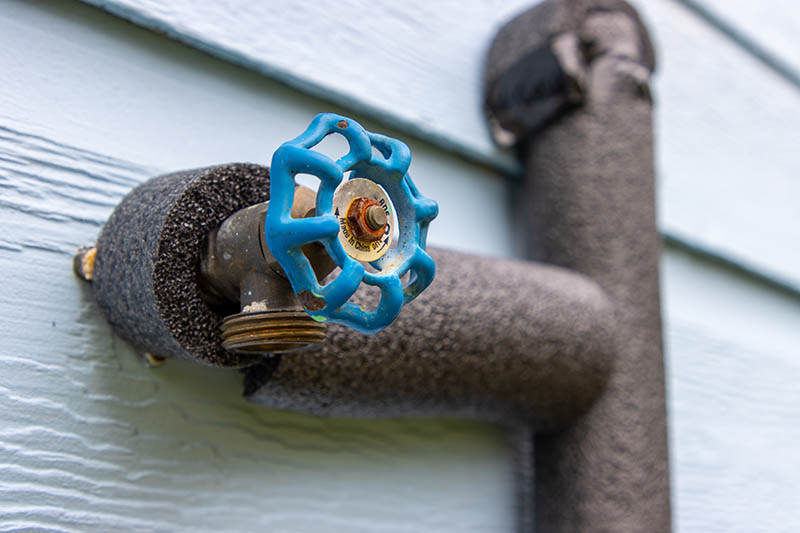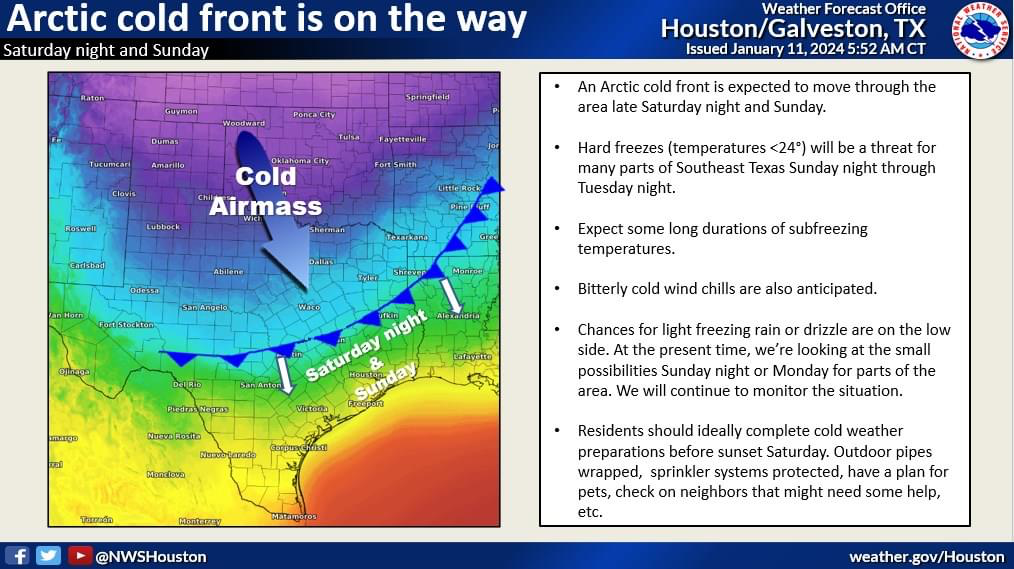
The Ultimate Guide for Freeze Prep
According to the National Weather Service, an Arctic cold front is forecast to move through the region later this weekend, followed by hard freezes through Tuesday night. Planning ahead is critical to protect yourself, your loves ones and your property in the event of power disruption, loss of communication services, and road closures.

Your dedicated My Neighborhood News team has compiled top tips from Fort Bend County Homeland Security & Emergency Management, Fort Bend County Master Gardeners, and Houston SPCA to help you prepare for this upcoming weather event.
According to the Fort Bend County Homeland Security & Emergency Management office, the primary difference between a light freeze and a hard freeze is temperature and length of time. In the event of a light freeze which 29-32 degrees, you will want to protect people, bring your pets inside and protect plants. If temperatures fall to 28 degrees or below for 4 hours or more which is a hard freeze, you need to include protecting outdoor pipes. At this time, a hard freeze is possible so begin preparations now.
Get ready, stay safe and stay warm!
-
Fully check and winterize your vehicle.
-
Keep your gas tank full.
- Have tire pressure checked.
- Have a phone charger, flashlight, first aid kit, blankets, warm clothes, jumper cables, bottled water and non-perishable snacks in your car.
- Stay off roads, if possible. If you become trapped in your car, stay inside the vehicle.
- Check local road conditions prior to driving. State highway information available at www.drivetexas.org.
Remember the 4 P's: People, Pets, Pipes and Plants
-
Dress in warm clothing. Wear coats and gloves when outdoors.
- Protect children and the elderly. Never leave them in a cold place or vehicle.
- Consider each person’s specific needs, including medication.
- Gather supplies that can lasts through several days if there’s a power outage, including extra batteries for radios and flashlights, food and bottled water.
- Watch for signs of frostbite and hypothermia and learn how to treat the symptoms. View more from the CDC on this topic here.
-
Provide MORE: Food, Water and Shelter: Outdoor pets need to consume 25 to 50 percent more calories than usual because the cold weather tends to deplete their energy. Make sure to provide fresh water for your pet and use plastic food and water bowls as your pet's tongue can stick to metal or the water can freeze. Outdoor pets should have a shelter or dog house that will protect them from the wind and is elevated. Add in blankets, towels or hay to help keep your pet warm and dry.
- Exercise Care with Cats, Canines and Cars: In the winter, the interior of an idle car can act as a refrigerator, so never leave pets in a car. Keep your cats indoors during cold weather as they may sleep under the hoods of cars to stay warm.
Give an outdoor cat a chance to escape by banging loudly on the car hood before starting your car.
-
Equine & Farm Animals: Be sure horses have access to a barn or a three-sided structure with a roof so they can escape the wind and cold. While not all horses will need to be blanketed, blankets will help horses keep warm and dry, especially in the rain or freezing temperatures. Frequently check water troughs and buckets to ensure the water is not frozen. Provide access to extra grain and hay if no grazing is available. Feed your horse unlimited forage during extreme cold to help them increase and regulate their body temperatures.
-
Wildlife: Just like humans, wildlife seek refuge from the cold. Set out birdhouses or leave natural debris like fallen leaves and branches in your yard to create hiding spots for small animals. Set up bird feeders with high-energy seeds and suet. Also, keep bowls of fresh, unfrozen water out for birds and other critters. More tips on helping wildlife can be found here.
-
Check sprinkler or irrigation systems. Make sure everything is turned off and drained.
- Disconnect any garden hoses from faucets. Drain the hoses thoroughly and store them in a garage or shed.
- Insulate or wrap pipes completely as any exposure to cold air can still freeze.
- Locate water shut off valve to your home in case of emergency.
- Refer to owners manual on tankless water heaters and water filtering system.
- If you have a swimming pool, either drain the circulation system or keep the pump motor running.
- Run the pump motor only in a short freeze, as running the motor for long periods could damage it.
- Covering Plants
- Tent the plant to trap heat and prevent radiation to a clear sky. This could be plastic, sheets, tarps, or blankets. You can also use large cardboard boxes, trash cans or build a frame of wood, covering it with cloth or plastic.
- Anchor your tent with bricks, lumber, buckets of water, or stakes. When tenting, remember to use the covering like a tent. It should cover the plant with the ends dropping to the ground. It is not helpful to wrap the plant like a lollipop. This method does not take advantage of the radiant heat coming upward from the ground. The tent method will capture this heat and help you plant survive the freeze.
- Add additional protection by raking the mulch away from the plant. Bare ground absorbs the sun’s heat while mulch will deflect the heat.
- Add strands of the C-9 Christmas lights. A mechanics light, or bathroom heater will also work. Do be careful with these last two so you don’t awake to flames in the backyard.
- Water
- Water plants several days ahead of cold weather, as water absorbs heat from the sun, stores it, then releases the warmth slowly. Watering before a freeze creates a source of warmth higher that the freezing point that will radiate through the night.
-
Use large trash cans or 5 gallon buckets filled with water, making sure the lid is on to help with radiation.
-
Banking
-
Bank soil up the trunk of grafted trees, first spraying a fungicide on the trunk of the tree.
-
After removing the soil bank from the trunk, spray again with a fungicide, making sure to remove the soil from around the roots.
-
- Insulation
-
Although it is common to use pipe insulation, sheets, Styrofoam or plastic to cover plants, results are spotty and do not work well overall.
-
Ideally, use sheets of fiberglass insulation by wrapping the plants prior to the freeze.
-
Remove insulation as soon as the freeze has passed, otherwise, the plant will overheat.
-
Consider covering the insulation with plastic to keep dry.
-
- If you lose power during a winter storm, remember to NEVER use your generator, grill, camp stove or similar devices indoors. Always follow the manufacturer’s guidelines.
- A gas stove or oven should NEVER be used to heat your home either, as this increases your chance of carbon monoxide poisoning.
- Protect yourself from carbon monoxide (CO) poisoning by installing a battery-operated CO detector and ensure that your existing smoke detectors have fresh, working batteries.
- Place space heaters on solid, flat surfaces, and make sure they have an automatic shut-off in the event that they tip over.
- Keep children and anything that can burn at least 3 feet away from all heating equipment.
Stay informed! Monitor the local forecast at www.weather.gov/hgx and follow Fort Bend County Homeland Security & Emergency Management @FBCOEM for updates.
By Tiffany Krenek, My Neighborhood News ![]()
 |
Tiffany Krenek has been on the My Neighborhood News team since August 2021. She is passionate about curating and sharing content that enriches the lives of our readers in a personal, meaningful way. A loving mother and wife, Tiffany and her family live in the West Houston/Cypress region. |








